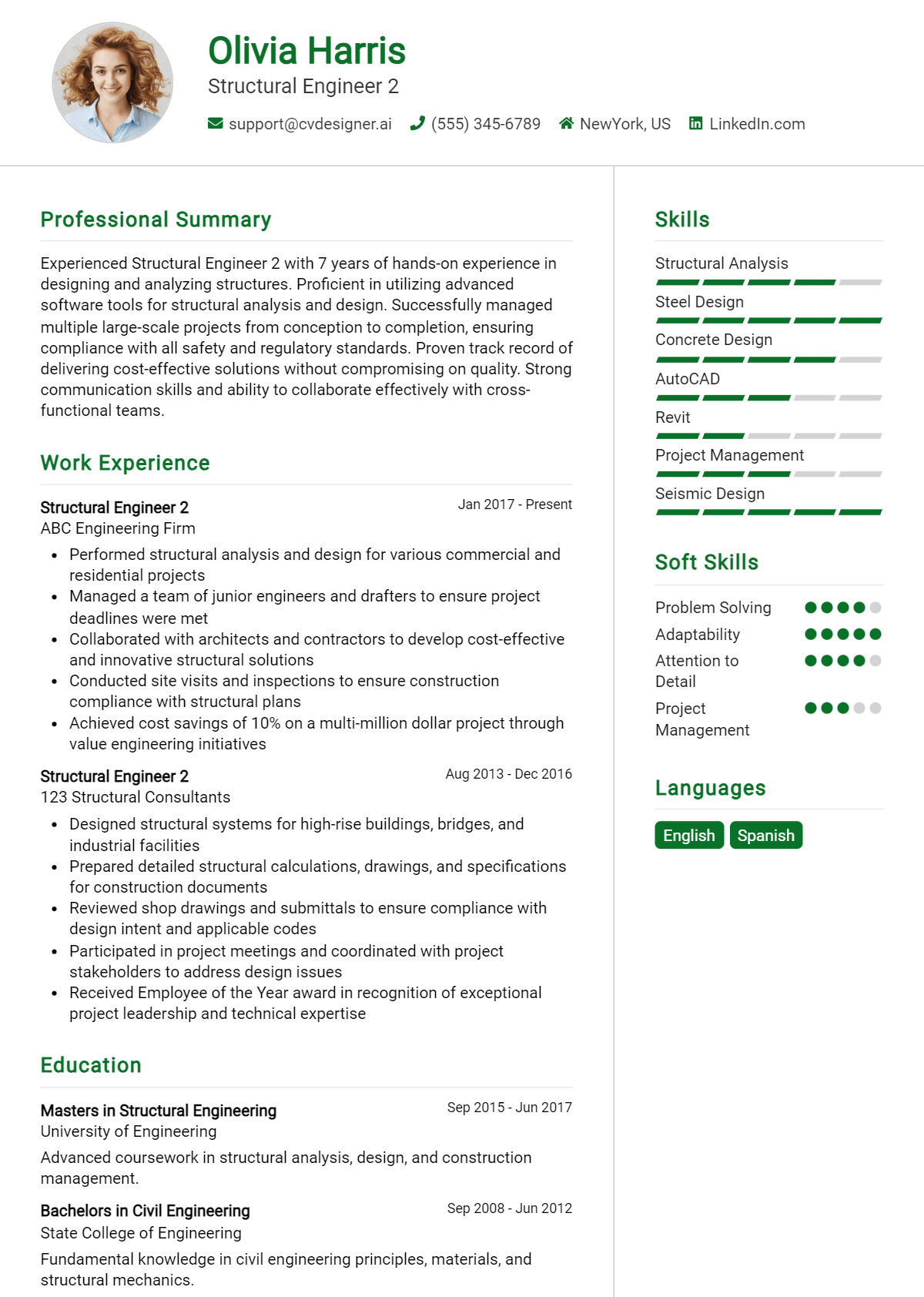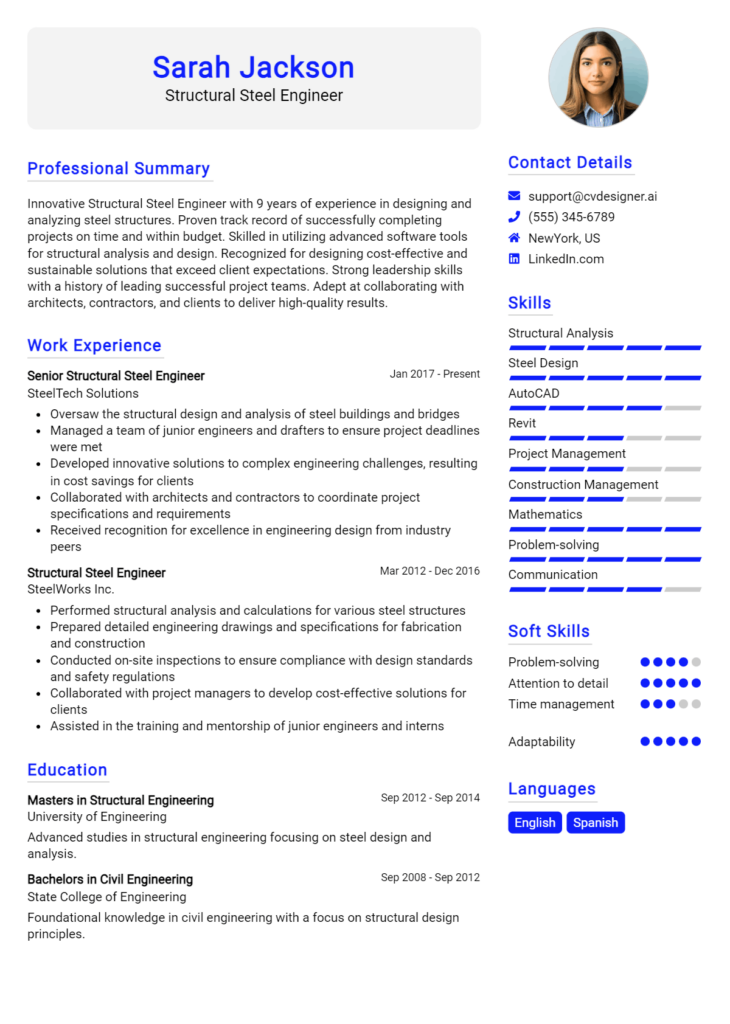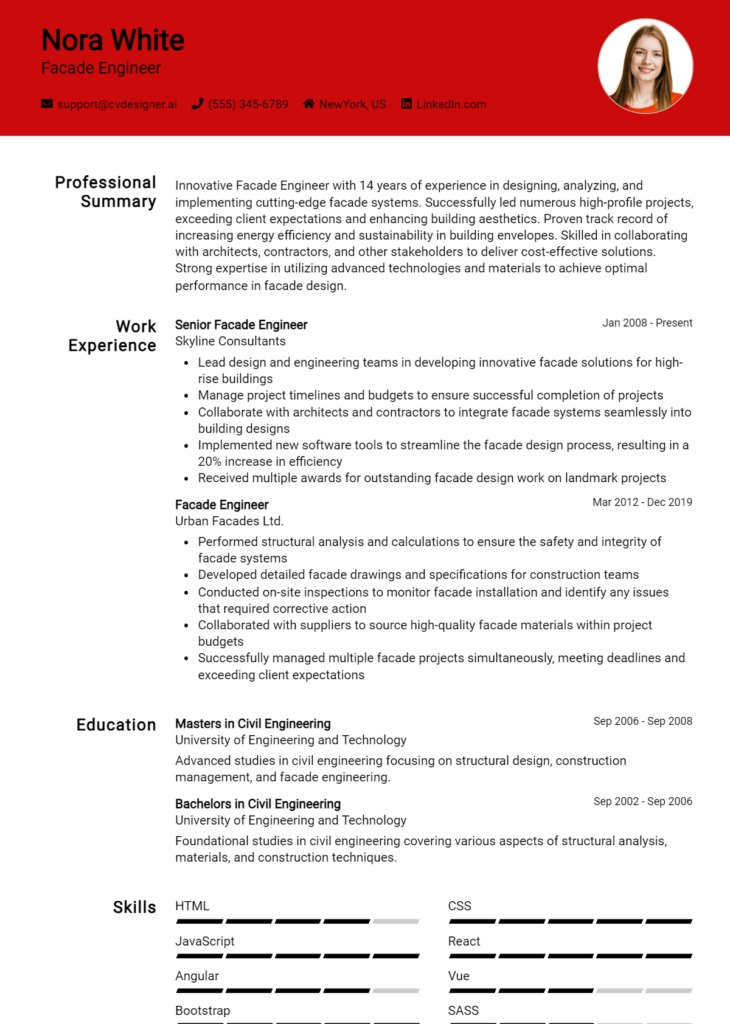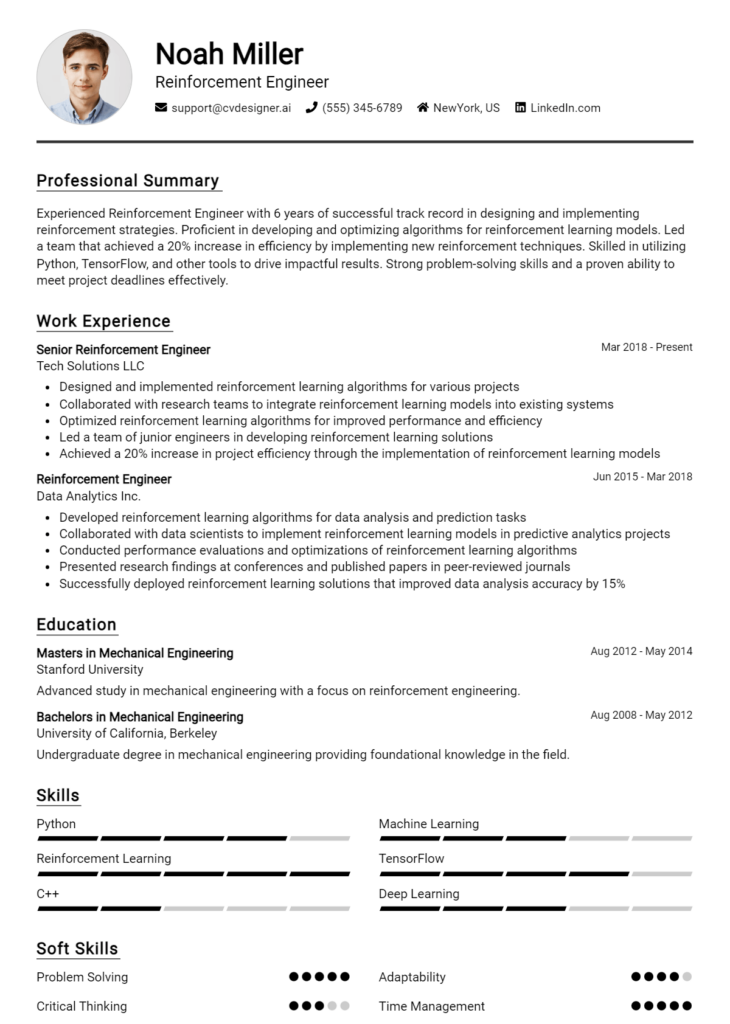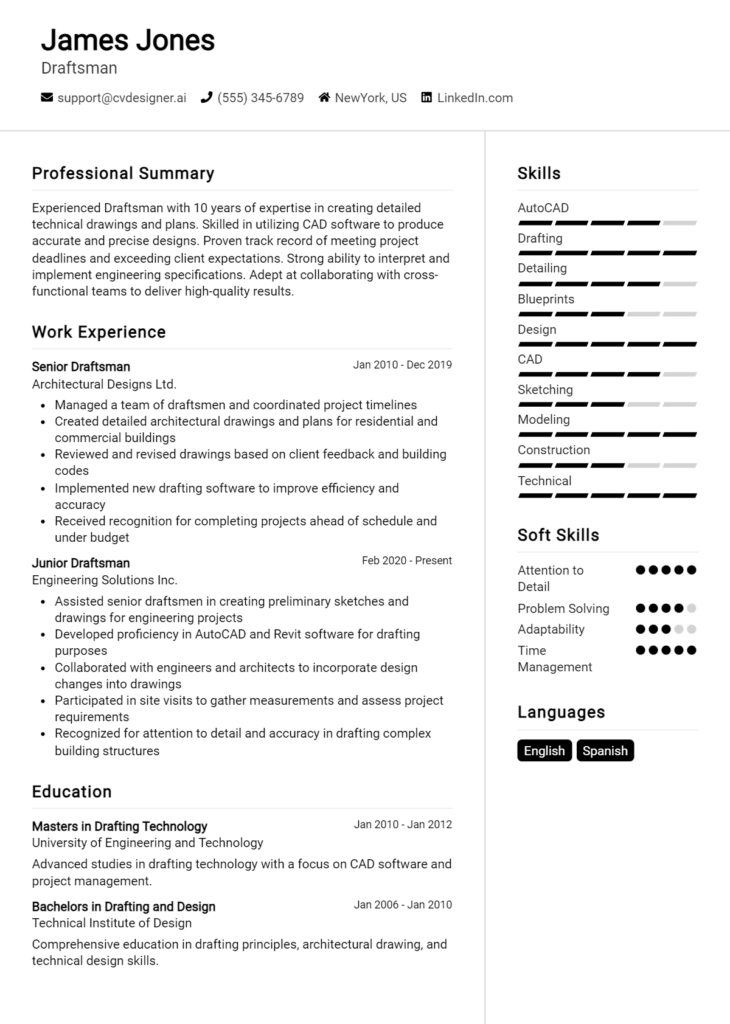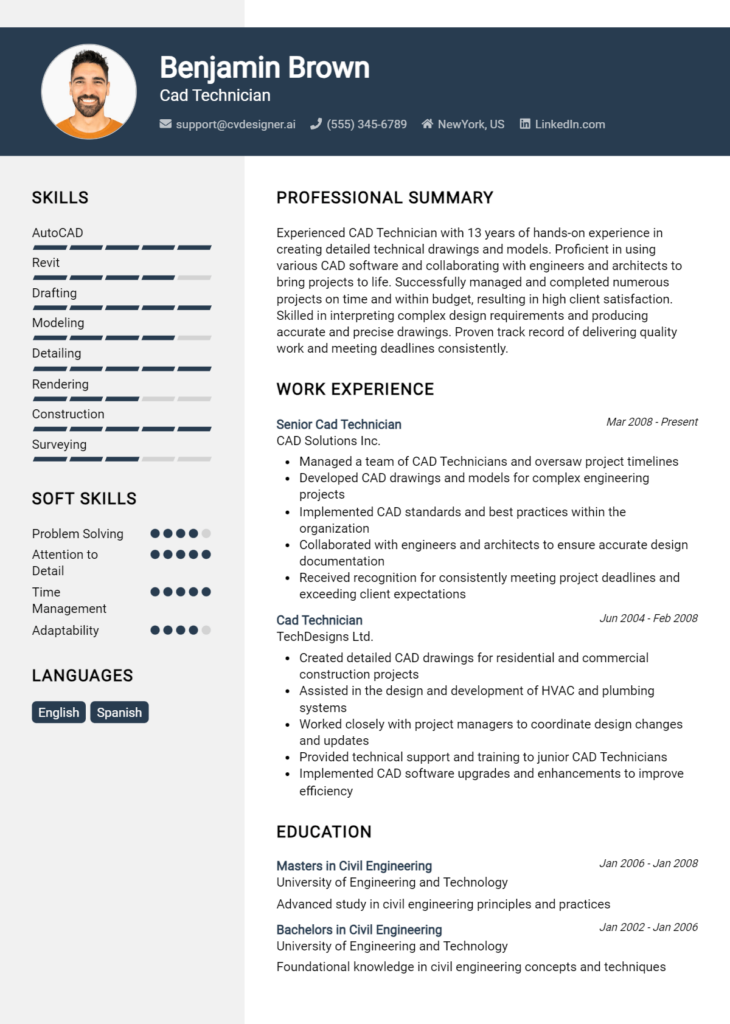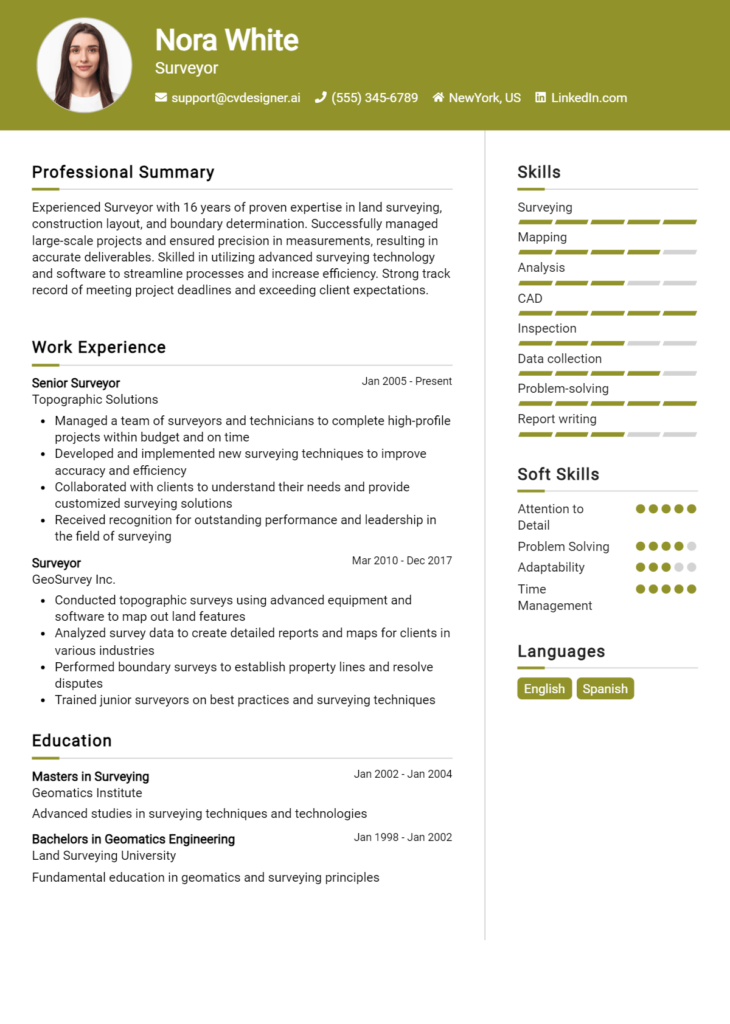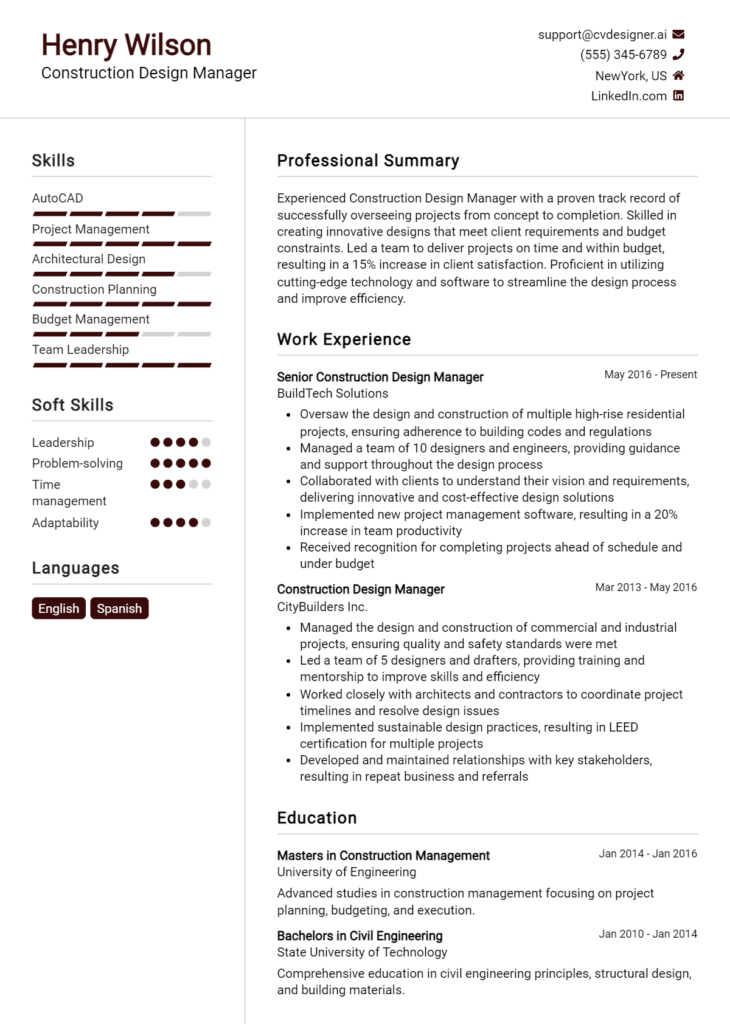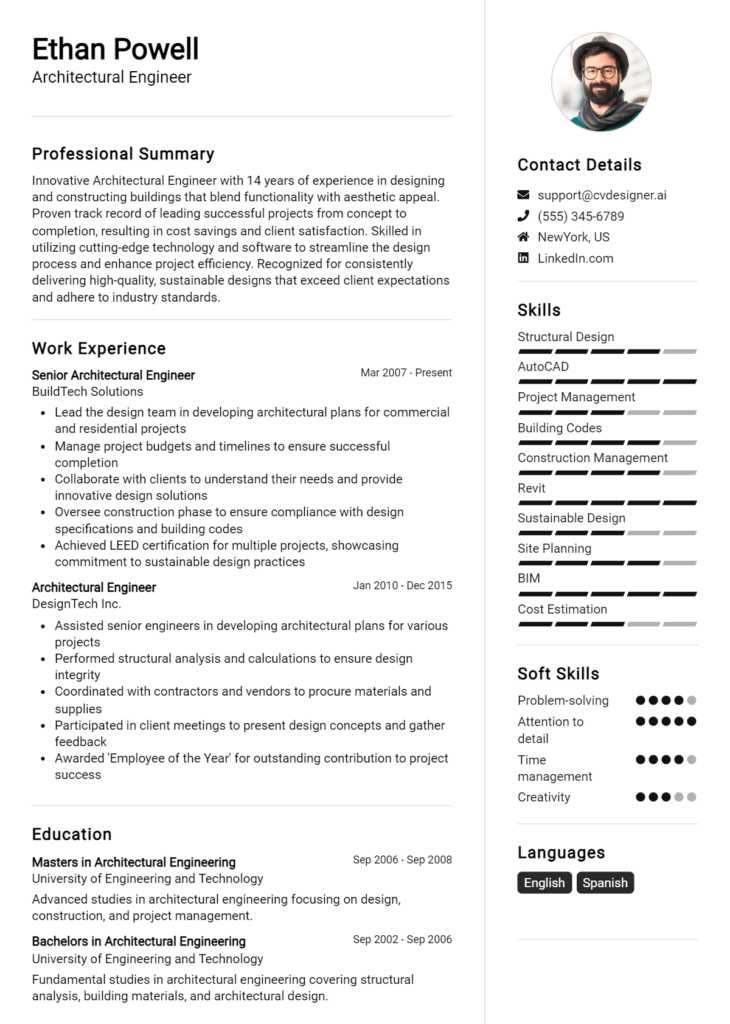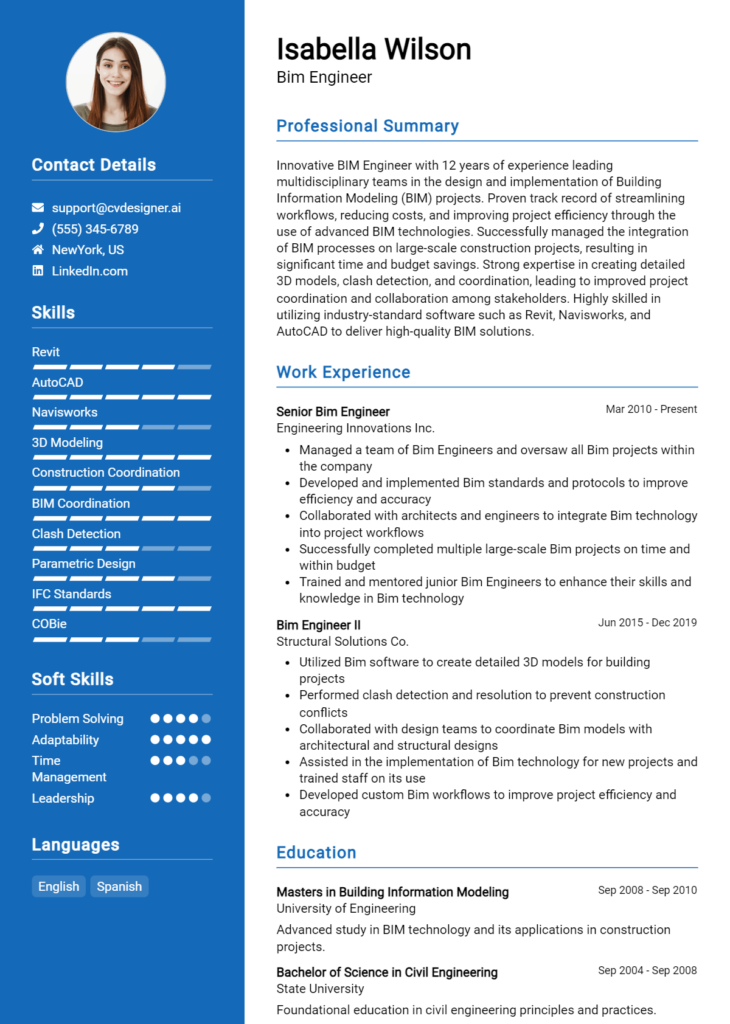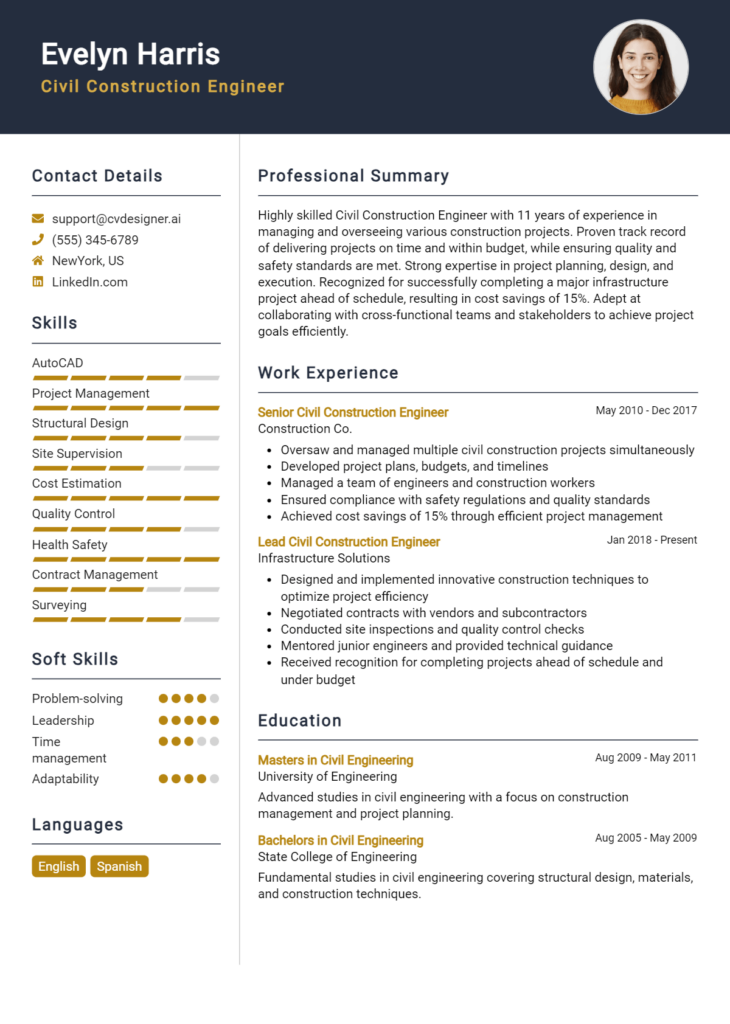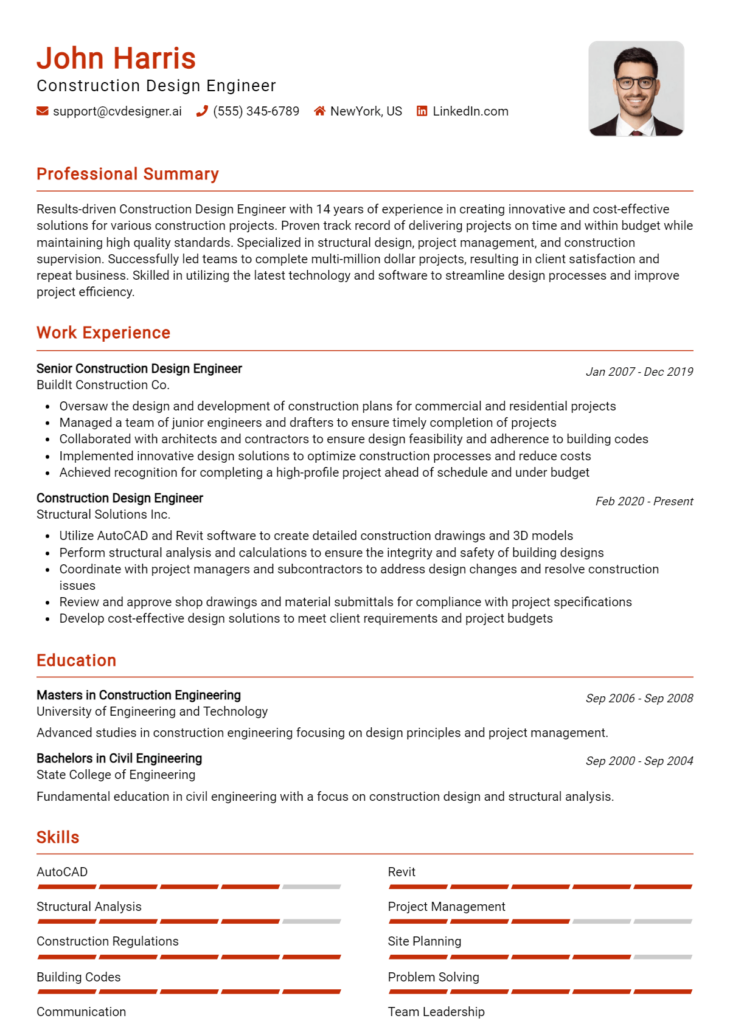Structural Engineer Core Responsibilities
A Structural Engineer is responsible for designing, analyzing, and ensuring the stability and safety of structures such as buildings and bridges. This role requires a strong foundation in technical skills, operational knowledge, and problem-solving abilities, as engineers must collaborate with architects, contractors, and other departments. Effective communication and teamwork are essential for successfully integrating diverse perspectives, ultimately contributing to organizational goals. A well-structured resume highlights these qualifications, showcasing a candidate's expertise in the field.
Common Responsibilities Listed on Structural Engineer Resume
- Designing and analyzing structural components and systems
- Conducting site inspections and assessments
- Preparing detailed engineering reports and documentation
- Collaborating with architects and other engineers on projects
- Ensuring compliance with building codes and regulations
- Performing structural load calculations and simulations
- Overseeing construction processes and quality control
- Providing technical guidance and support to project teams
- Managing project timelines and budgets
- Conducting risk assessments and proposing mitigation strategies
- Staying updated on industry trends and advancements
High-Level Resume Tips for Structural Engineer Professionals
In today’s competitive job market, a well-crafted resume is essential for Structural Engineer professionals aiming to make a lasting impression on potential employers. Your resume is often the first opportunity to showcase your skills, achievements, and unique qualifications, making it a critical tool in your job search arsenal. A compelling resume not only highlights your technical expertise but also tells the story of your career progression and contributions to successful projects. This guide will provide practical and actionable resume tips specifically tailored for Structural Engineer professionals, ensuring that you stand out in a crowded field.
Top Resume Tips for Structural Engineer Professionals
- Tailor your resume for each job application by aligning your skills and experiences with the specific requirements outlined in the job description.
- Showcase relevant experience prominently, emphasizing your roles in significant projects like bridges, buildings, or other infrastructure developments.
- Quantify your achievements with concrete data—include metrics such as cost savings, project timelines, or improvements in safety standards.
- Highlight industry-specific skills, including familiarity with design software (e.g., AutoCAD, Revit) and knowledge of building codes and regulations.
- Include a dedicated section for certifications and licenses, such as Professional Engineer (PE) status, which can set you apart from other candidates.
- Use action verbs to describe your contributions, such as "designed," "developed," and "implemented," to convey a sense of initiative and impact.
- Incorporate keywords from the job posting to enhance your resume's visibility in applicant tracking systems (ATS).
- Maintain a clean and professional format, using clear headings, bullet points, and consistent font styles to improve readability.
- Consider adding a brief summary or objective statement that succinctly captures your career goals and highlights your most relevant qualifications.
By implementing these tips, you can significantly enhance your resume's effectiveness, increasing your chances of landing a job in the Structural Engineer field. A well-structured and tailored resume not only showcases your qualifications but also demonstrates your commitment to the profession, making you a compelling candidate for potential employers.
Why Resume Headlines & Titles are Important for Structural Engineer
In the competitive field of structural engineering, crafting a compelling resume is essential for standing out among candidates. A strong resume headline or title serves as the first impression for hiring managers, offering a concise summary of the candidate's key qualifications and expertise. This impactful phrase can instantly grab attention and set the tone for the rest of the resume. By being concise, relevant, and directly related to the specific job being applied for, an effective headline can significantly enhance a candidate's chances of securing an interview.
Best Practices for Crafting Resume Headlines for Structural Engineer
- Keep it concise: Aim for one to two impactful phrases.
- Be role-specific: Tailor the headline to the specific structural engineering position.
- Highlight key qualifications: Include relevant certifications, skills, or experiences.
- Use strong action words: Choose powerful verbs that convey expertise and accomplishments.
- Focus on results: Emphasize achievements that demonstrate value to potential employers.
- Avoid jargon: Use clear language that is easily understood by hiring managers.
- Incorporate keywords: Include industry-specific terms that align with the job description.
- Revise and refine: Continuously update the headline to reflect new skills or experiences.
Example Resume Headlines for Structural Engineer
Strong Resume Headlines
"Experienced Structural Engineer with a Proven Track Record in High-Rise Building Design"
“Licensed Structural Engineer Specializing in Sustainable Infrastructure Solutions”
“Detail-Oriented Structural Engineer with 10+ Years of Experience in Seismic Design”
“Innovative Structural Engineer Committed to Enhancing Safety and Efficiency in Construction”
Weak Resume Headlines
“Engineer Looking for Work”
“Structural Engineer with Experience”
“Professional Seeking Opportunities”
Strong headlines are effective because they are specific, showcasing the candidate's unique strengths and relevant experience in structural engineering. They communicate value and expertise in a way that resonates with hiring managers. In contrast, weak headlines fail to impress due to their vagueness and lack of specificity, making it difficult for employers to see the candidate's qualifications or differentiate them from the competition. A compelling headline can make all the difference in capturing attention and securing an interview.
Writing an Exceptional Structural Engineer Resume Summary
A well-crafted resume summary is essential for a Structural Engineer as it serves as the first impression a hiring manager will have of the candidate. It quickly captures attention by highlighting key skills, relevant experience, and notable accomplishments that align with the job role. An effective summary is concise yet impactful, providing a snapshot of the candidate’s qualifications that is tailored to the specific position they are applying for. This focused approach not only demonstrates the applicant's understanding of the role but also showcases their potential value to the organization.
Best Practices for Writing a Structural Engineer Resume Summary
- Quantify Achievements: Use concrete numbers to highlight your accomplishments (e.g., “designed structures that reduced costs by 20%”).
- Focus on Relevant Skills: Emphasize technical skills and software proficiencies that are directly applicable to the job.
- Tailor the Summary: Customize your summary for each job application by aligning it with the specific job description.
- Highlight Key Experience: Mention years of experience and specific industries or projects that relate to the position.
- Use Action-Oriented Language: Start sentences with strong action verbs to convey a sense of proactivity.
- Keep it Concise: Aim for 3-5 sentences that clearly communicate your strengths without being overly verbose.
- Showcase Certifications: Include any relevant licenses or certifications that enhance your qualifications.
Example Structural Engineer Resume Summaries
Strong Resume Summaries
Dynamic Structural Engineer with over 8 years of experience in designing and overseeing the construction of residential and commercial buildings. Successfully led a team that developed a bridge project 15% under budget while ensuring compliance with all safety regulations.
Results-driven Structural Engineer skilled in utilizing AutoCAD and SAP2000 to create innovative structural designs. Recognized for enhancing structural integrity in high-rise buildings, achieving a 30% reduction in material costs through optimized design strategies.
Detail-oriented Structural Engineer with 5+ years in seismic design and analysis. Spearheaded a project that improved building resilience against earthquakes, which resulted in a 25% increase in safety ratings for municipal structures.
Weak Resume Summaries
Experienced engineer looking for a job in a structural engineering firm.
I am a structural engineer with some experience in various projects and have skills in design.
The strong resume summaries are effective because they provide specific examples of achievements, quantify results, and directly relate to the skills and experiences necessary for the role of a Structural Engineer. In contrast, the weak resume summaries lack detail, provide no measurable outcomes, and fail to convey the candidate's unique qualifications, making them less compelling to hiring managers.
Work Experience Section for Structural Engineer Resume
The work experience section of a Structural Engineer resume plays a critical role in illustrating a candidate's qualifications and expertise in the field. This section not only highlights the technical skills acquired through previous positions but also demonstrates the candidate's ability to manage teams effectively and deliver high-quality projects. By quantifying achievements—such as cost savings, project timelines, and structural integrity improvements—and aligning experiences with industry standards, candidates can significantly enhance their appeal to potential employers. A well-crafted work experience section serves as a testament to a candidate's professional journey and their readiness to tackle complex engineering challenges.
Best Practices for Structural Engineer Work Experience
- Focus on quantifiable achievements, such as percentage reductions in costs or improvements in project efficiency.
- Highlight specific technical skills relevant to structural engineering, such as software proficiency or design methodologies.
- Include details about leadership roles, showcasing experience in managing teams and coordinating projects.
- Align experiences with industry standards and best practices to demonstrate familiarity with current trends.
- Utilize action verbs to convey contributions effectively, portraying a proactive and engaged professional.
- Tailor the work experience section to the job description, emphasizing relevant experiences that match the employer's needs.
- Incorporate collaborative efforts, detailing how teamwork led to successful project outcomes.
- Provide context for each role, explaining the scope and significance of projects undertaken.
Example Work Experiences for Structural Engineer
Strong Experiences
- Led a team of 5 engineers in the design of a 200,000 square-foot commercial building, completing the project 15% under budget and 3 weeks ahead of schedule.
- Implemented a new structural analysis software that improved design accuracy by 25%, resulting in a 10% reduction in material costs for multiple projects.
- Collaborated with architects and contractors on a high-rise project, ensuring compliance with safety standards and receiving a commendation for outstanding teamwork from stakeholders.
- Managed the structural assessment of a historic bridge, successfully securing funding for restoration by demonstrating its value to the community and reducing potential hazards.
Weak Experiences
- Worked on various engineering projects with little detail provided.
- Assisted in the design of structures without specifying the role or contributions made.
- Participated in team meetings and discussions without outlining specific outcomes or achievements.
- Completed tasks as assigned with no mention of impact or results from the work performed.
The examples provided illustrate the distinguishing factors between strong and weak experiences. Strong experiences are characterized by specific, quantifiable results that demonstrate leadership, technical expertise, and collaboration. In contrast, weak experiences lack detail and fail to convey the candidate's contributions or the impact of their work, making it difficult for potential employers to assess their qualifications effectively.
Education and Certifications Section for Structural Engineer Resume
The education and certifications section of a Structural Engineer resume plays a vital role in establishing a candidate's qualifications and expertise in the field. This section not only highlights the candidate's academic background but also emphasizes their commitment to continuous learning through industry-relevant certifications and specialized training. By providing relevant coursework and credentials, candidates can significantly enhance their credibility, demonstrating their alignment with the job requirements and showcasing their readiness to tackle the challenges of a structural engineering role.
Best Practices for Structural Engineer Education and Certifications
- Prioritize relevant degrees, such as a Bachelor’s or Master’s in Civil or Structural Engineering.
- Include industry-recognized certifications, such as Professional Engineer (PE) or Structural Engineer (SE) licenses.
- List specialized training or coursework that relates directly to the job role, such as seismic design or advanced materials.
- Use clear formatting to distinguish between degrees, certifications, and training for easy readability.
- Highlight any continuing education courses or workshops that show commitment to staying updated in the field.
- Specify the dates of completion for each qualification to reflect your most current knowledge.
- Consider including honors or awards received during your education that demonstrate excellence.
- Tailor the section to match the specific requirements outlined in the job description.
Example Education and Certifications for Structural Engineer
Strong Examples
- Bachelor of Science in Civil Engineering, University of XYZ, Graduated May 2020
- Master of Science in Structural Engineering, University of ABC, Graduated December 2022
- Licensed Professional Engineer (PE), State of California, License No. 123456
- Certification in Seismic Design Principles, American Society of Civil Engineers, Completed January 2023
Weak Examples
- Bachelor of Arts in History, University of XYZ, Graduated May 2018
- Certification in Basic Computer Skills, Online Learning Academy, Completed June 2020
- High School Diploma, Local High School, Graduated June 2015
- Certification in First Aid and CPR, Red Cross, Completed March 2021
The examples listed as strong are considered relevant because they directly pertain to the field of structural engineering, showcasing both educational achievements and recognized credentials that align with industry standards. Conversely, the weak examples reflect qualifications that are either unrelated to structural engineering or outdated, failing to demonstrate the candidate's expertise or commitment to the profession.
Top Skills & Keywords for Structural Engineer Resume
In the competitive field of structural engineering, having a well-crafted resume that highlights pertinent skills is essential for standing out to potential employers. Skills demonstrate a candidate's ability to tackle complex engineering challenges, collaborate effectively with teams, and adhere to industry standards. By showcasing both hard and soft skills, a structural engineer can illustrate their technical expertise and interpersonal capabilities, making them a more attractive candidate. This balance is crucial, as technical skills ensure the integrity and safety of structures, while soft skills enable effective communication and project management. For a comprehensive understanding of the skills necessary for a structural engineering role, it is vital to delve into the key attributes that should be included in a resume.
Top Hard & Soft Skills for Structural Engineer
Soft Skills
- Effective communication
- Team collaboration
- Problem-solving
- Attention to detail
- Time management
- Adaptability
- Critical thinking
- Leadership
- Project management
- Creativity
Hard Skills
- Structural analysis and design
- Proficiency in AutoCAD and Revit
- Knowledge of building codes and standards
- Familiarity with materials science
- Finite element modeling (FEM)
- Load calculations
- Structural dynamics
- Geotechnical engineering principles
- Construction methods and project estimation
- Risk assessment and management
By emphasizing these skills in your resume, alongside relevant work experience, you can present a compelling case for your candidacy in the field of structural engineering.
Stand Out with a Winning Structural Engineer Cover Letter
Dear [Hiring Manager's Name],
I am writing to express my interest in the Structural Engineer position at [Company Name], as advertised on [Job Board/Company Website]. With a Bachelor’s degree in Civil Engineering from [University Name] and over [X years] of hands-on experience in structural design and analysis, I am confident in my ability to contribute effectively to your team. My background includes working on a diverse range of projects, from residential buildings to large-scale commercial infrastructures, where I have successfully implemented innovative design solutions while ensuring compliance with safety standards and regulations.
In my previous role at [Previous Company Name], I led a team of engineers and drafters in the design of a multi-story commercial complex, where I utilized advanced software tools such as AutoCAD and SAP2000 for structural analysis. My strong analytical skills and attention to detail allowed me to identify potential issues early in the design phase, resulting in a 15% reduction in project costs and a significant improvement in lead time. I thrive in collaborative environments, and I pride myself on my ability to communicate complex engineering concepts clearly to clients and stakeholders, ensuring that all parties are aligned throughout the project lifecycle.
At [Company Name], I am particularly excited about the opportunity to work on [specific project or aspect of the company], as I believe my experience with [related experience or technology relevant to the company] aligns perfectly with your current initiatives. I am eager to bring my expertise in sustainable design practices and innovative engineering solutions to [Company Name], contributing to your mission of delivering high-quality projects that meet both client expectations and environmental standards.
Thank you for considering my application. I look forward to the opportunity to discuss how my background, skills, and enthusiasms align with the goals of [Company Name]. I am excited about the possibility of working together to create structures that stand the test of time while advancing the field of structural engineering.
Sincerely,
[Your Name]
[Your Phone Number]
[Your Email Address]
Common Mistakes to Avoid in a Structural Engineer Resume
When crafting a resume as a Structural Engineer, it's crucial to present your skills and experiences in the best light possible. However, many applicants make common mistakes that can detract from their qualifications and ultimately hinder their chances of landing an interview. Understanding these pitfalls can help you create a more effective resume that stands out in a competitive job market.
Using a Generic Template: Many candidates rely on one-size-fits-all templates, which can make their resumes look unoriginal and fail to highlight specific skills relevant to structural engineering.
Neglecting Relevant Experience: Failing to emphasize relevant project experience or technical skills can lead to missed opportunities, as employers are often looking for specific competencies in areas like CAD software or structural analysis.
Vague Job Descriptions: Providing unclear or overly broad descriptions of previous roles can leave hiring managers confused. It’s essential to be specific about your contributions and achievements.
Lack of Quantifiable Achievements: Not including measurable outcomes or statistics to demonstrate the impact of your work can make your resume less compelling. Use numbers to showcase results, such as cost savings or project timelines.
Ignoring Keywords: Many companies use applicant tracking systems (ATS) to filter resumes. Failing to incorporate relevant keywords from the job description can result in your resume being overlooked.
Poor Formatting: A cluttered or unprofessional layout can make it difficult for hiring managers to read your resume. Ensure your document is well-organized, with clear headings and consistent formatting.
Typos and Grammatical Errors: Mistakes in spelling or grammar can reflect poorly on your attention to detail, which is crucial in engineering. Always proofread your resume or have someone else review it before submission.
Overloading Information: Including too much information can overwhelm recruiters. Focus on the most relevant experiences and skills that align with the job you’re applying for, keeping your resume concise and focused.
Conclusion
As a Structural Engineer, your resume plays a crucial role in showcasing your technical skills, project experience, and problem-solving abilities. In this article, we explored the essential elements that should be included in your resume, such as your educational background, relevant certifications, and hands-on experience with various materials and construction methods. We also emphasized the importance of tailoring your resume to highlight specific projects that demonstrate your expertise and the impact of your work on previous employers.
In addition, we discussed how to effectively present your soft skills, like teamwork and communication, which are vital in collaborative engineering environments. Remember, your resume is not just a list of qualifications; it should tell the story of your career and how you can contribute to potential employers.
Now is the perfect time to review and enhance your Structural Engineer resume. Utilize resources like resume templates to find a design that best fits your professional style. For a more personalized touch, consider using our resume builder to create a standout resume that reflects your unique qualifications. You can also browse through our resume examples for inspiration and ideas on how to structure your content effectively. Additionally, don’t forget to check out our cover letter templates to complement your resume and make a strong impression on hiring managers. Take action today to ensure your resume is as impressive as your engineering skills!

